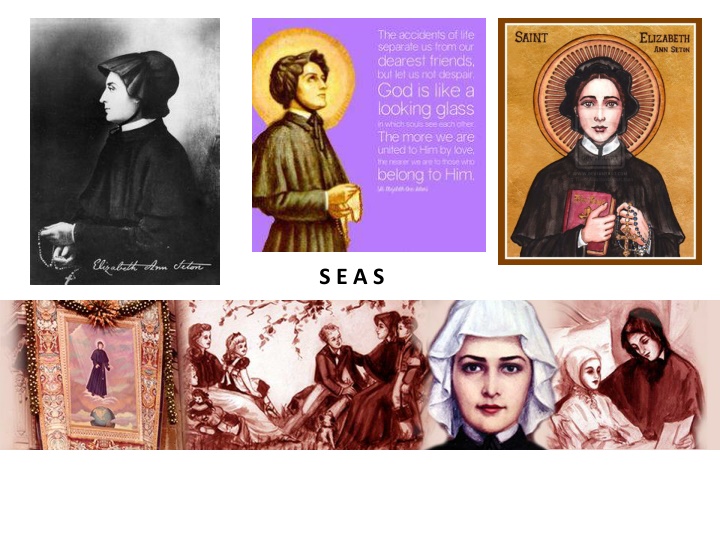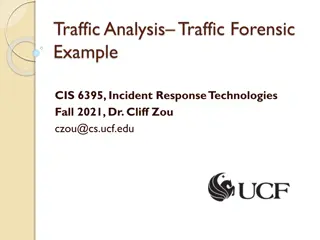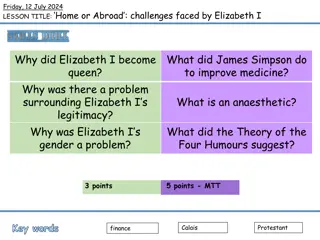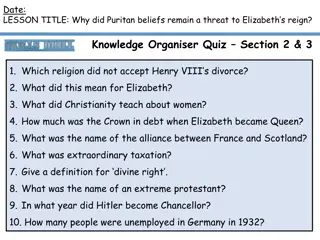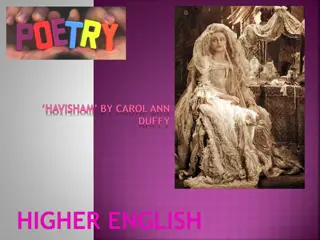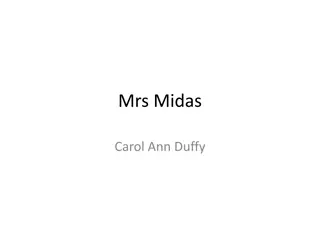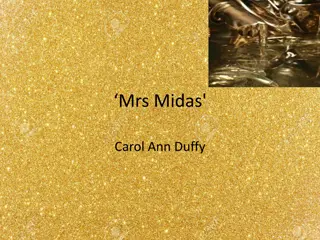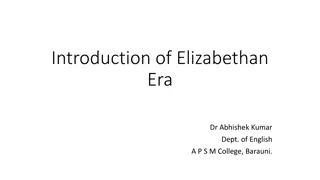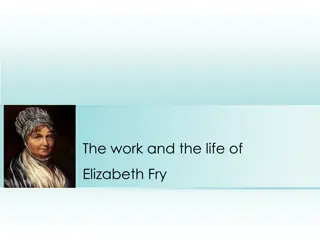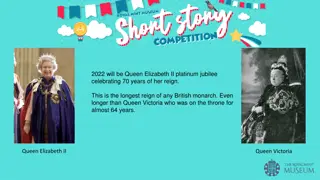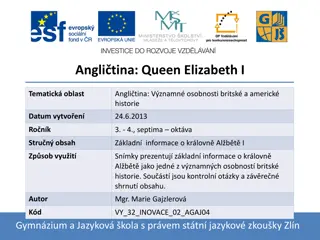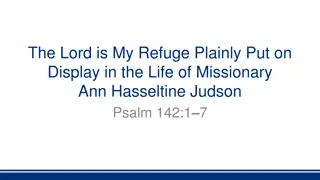The Inspiring Life of St. Elizabeth Ann Seton
St. Elizabeth Ann Seton, a widowed New York socialite who embraced the Catholic faith, founded a community of women in 1809. Despite facing personal tragedies and challenges, she established the first Catholic parochial school system in the United States. Her legacy continued through the Daughters of Charity, who served in various capacities, including during wars. Seton was beatified in 1963 and canonized in 1975, recognizing her significant contributions to education and charitable work.
Download Presentation

Please find below an Image/Link to download the presentation.
The content on the website is provided AS IS for your information and personal use only. It may not be sold, licensed, or shared on other websites without obtaining consent from the author.If you encounter any issues during the download, it is possible that the publisher has removed the file from their server.
You are allowed to download the files provided on this website for personal or commercial use, subject to the condition that they are used lawfully. All files are the property of their respective owners.
The content on the website is provided AS IS for your information and personal use only. It may not be sold, licensed, or shared on other websites without obtaining consent from the author.
E N D
Presentation Transcript
SETON S E A S
St. Elizabeth Ann Seton (1774 1821) In the United States, the Daughters of Charity trace their origins to Elizabeth Ann Seton, a widowed New York socialite who embraced the Catholic faith and founded a community of women in 1809. Born in 1774, Elizabeth Ann Bayley was the daughter of a prominent physician. At the age of 19, she married William Seton, whose family owned a successful import business. They had two sons and three daughters. As was custom for prominent matrons of the time, Mrs. Seton embarked on a career of public charity. She founded a society of women known as the Widow s Society to raise money and give aid to poverty-stricken widows in New York City. The good works of this group prompted neighbors to refer to them as the Protestant Sisters of Charity. Through most of their married life, William Seton suffered from tuberculosis. In 1803, after suffering severe business losses, including bankruptcy, William s health deteriorated rapidly. When he expressed a desire to go to Italy to try to improve his health, Elizabeth left four of her children with relatives, and went abroad with William and their 8-year-old daughter. After weeks of travel, William died in the Filicchi home in Pisa. The widowed Elizabeth and her daughter sailed home to America in April 1804. Confronted with the need to support her five children without any help from her husband or her husband s business, which was now bankrupt, Elizabeth opened a school in her home. After that venture failed, she decided to seek employment elsewhere.
After much prayer and counseling from Archbishop John Carroll Elizabeth accepted an offer from the president of St. Mary s Seminary in Baltimore to establish a school for girls. She moved to Baltimore in 1808 and opened a small school. This modest beginning marked the start of the Catholic parochial school system in the United States. Elizabeth Seton took vows of poverty, chastity and obedience on March 25, 1809 and was given the title of Mother by Archbishop Carroll. That June, she and her followers donned a simple black religious habit and set out for Emmitsburg, Maryland, situated 50 miles west of Baltimore. Their first house was a cottage on the grounds of St. Mary s College. On July 31, the group began community life as the Sisters of Charity of St. Joseph. In 1810, the sisters adopted the rules written by St. Vincent de Paul for the Daughters of Charity in France. Word of the sisters talents and good works spread quickly and soon Mother Seton was besieged by requests for help in setting up parochial schools to serve the burgeoning population along the Eastern seaboard. In 1814, the Sisters of Charity began opening parish-free schools, academies and orphanages along the coast.
Mother Seton died at the age of 46 in 1821. The members of her community continued Elizabeth Seton s work. In 1830, the sisters were running orphanages and schools as far west as Cincinnati and New Orleans and had established the first hospital west of the Mississippi in St. Louis. Much later, in a response to a request from President Abraham Lincoln, more than 200 Daughters of Charity served on battlefields and in military hospitals during the Civil War. They served again in the Spanish American War at the end of the 19th century, when American Daughters in Puerto Rico shared supplies with Spanish Daughters nursing soldiers of the opposing army. Elizabeth Ann Seton, founder of the American Daughters of Charity, was beatified on March 17, 1963 and canonized on Sept. 14, 1975.
St. Elizabeths Truths of Faith The accepting and embracing of God s will The Will, as she called it was a keynote in her spiritual life. Having lost her mother at an early age, Elizabeth felt great comfort in the idea that the Blessed Virgin was truly her mother. She asked the Blessed Virgin to guide her to the True Faith. The Eucharist, scripture, and prayer were three strongholds that strengthened her faith and nourished her in her mission of Christian formation and education. She had a particular fervor for the Real Presence of our Lord in the Blessed Sacrament.
St. Elizabeth Ann possessed courage as she stood up for her decision to convert to Catholicism.
Be children of the Church The glorious heritage of Elizabeth Ann Seton is above all an ecclesial heritage of strong faith and pure love for God and for others: faith and love that are nourished on the Eucharist and on the Word of God. Elizabeth said, on her deathbed, on January 2, 1821: Be children of the Church .
Spiritual Gems of Elizabeth Ann Seton: Charity Sisters of Charity! Your admirable name must excite in you every preparation to do justice to your vocation. To speak the joy of my soul at the prospect of being asked to assist the poor, visit the sick, comfort the afflicted, clothe little innocents and teach them to love God! There I must stop. Religion does not limit the powers of the affections, for our Blessed Savior sanctifies and approves in us all the endearing ties and connections of our existence. Religion alone can bind that cord over which neither circumstances, time, nor death have any power. Suffer all from others without giving them anything to suffer; bear with their defects as we wish them to bear with us.
When you are excited to impatience, think for a moment how much more reason God has to be angry with you than you have for anger against any human being; and yet how constant is His patience and forbearance. Through divine love and grace, not to speak of anyone unless to their advantage, nor of myself unless of God's goodness. To avoid all curiosity. Not to express discontent.... Not to be angry with anything but what displeases God. To be gentle to the children and humble to all. To lift up my heart on all occasions, great and small, to Him. To do violence to self on a thousand occasions. Renounce all satisfactions in particular, endure the weakness of some, the murmurings of others, the delicacy of a third, yet forgetting no one.
The Judge will show mercy in proportion as we show it. Human passions and weaknesses, to be sure, are never extinct, but they cannot triumph in a heart possessed by peace. Blessed Guardians... be watchful. Help us to use well the grace of the moment in the care and instruction of the little ones under our charge. Watch over them with us. When you ask too much as first you often gain nothing at last, and if the heart is lost, all is lost.... The faults of young people must be moved by prayers and tears, because they are constitutional and cannot be frightened out.
Be to them as our guardian angels are to us. Now, this beautiful season of Advent, do try to take its spirit, my friend; to think of it as the last. You have so many opportunities to love our Jesus in His poor, to make the little Babe so many presents before Christmas comes. You know, in our sweet meditation it says now He is our tender Babe, stretching His arms and offering His tears for us, by and by He will be our lawful Judge. It is a sweet thought to dwell on, that those I most tenderly love, love God, and if we do not meet again here, in heaven we shall be separated no more.
A School for Girls Archbishop Carroll then invited Mother Seton to open a school for girls. A retired sea captain purchased a farm for her in Emmitsburg, Maryland, which she and her sisters turned into a school. Mother Seton named the school St. Joseph s Academy, which became the first parochial school in the United States. Mother Seton, who was a homeschooling mother, had no college degree but evidently was a great educator. Her holiness and sincere desire to help children learn their Catholic Faith made her a popular success among the Catholics in the Emmitsburg area.
Sources http://famvin.org/en/about-2/ A network of people, supported and connected by websites, including this one, for news, reference materials, formation materials and a variety of social networks. The Vincentian Family connecting, collaborating and evangelizing: a living, growing community of more than 2 million people seeking to follow Christ, the evangelizer of the poor in the model presented by the life of Vincent de Paul and his collaborator, Louise de Marillac.
Sources The National Shrine of Saint Elizabeth Ann Seton https://setonshrine.org http://www.beliefnet.com/faiths/catholic/sain ts/e/elizabeth-ann- seton.aspx#RUFIwXjSxW4V0HIq.99
Sources https://www.youtube.com/watch?v=- wzAedYHtwg Discovering our Saint's - St. Elizabeth Ann Seton CCTNtv http://theophilia.deviantart.com/art/st- elizabeth-ann-seton-icon-346654801 http://www.bayleybulletin.com/st-elizabeth- ann-seton-a-life-of-pain-joy/
Group Discussion Question 1. Mother Seton was happy to be a nun and once described her convent rules as a bit and bridle of gold. Obligations were reins of silk. She did not count the cost. She believed every truth of the Church of Jesus, and practiced every value His Church taught. She did not pick and choose which doctrines she believed in or which virtues she would follow and which she would not follow. Is this a difficult path to pursue as a practicing Catholic today?
Group Discussion Question 2. Mother Seton was a saint because she was unconditional in her devotion to the teachings of Christ. She knew instinctively that being a wife, a mother, and then a nun were each a special gift. How do you keep your Catholic faith strong and centered as Saint Elizabeth Ann Seton did?
Group Discussion Question 3. Parents were particularly impressed because, being a former Protestant who spent hours a day studying the Bible, Elizabeth was known for illustrating her teaching by quoting the Gospel, especially the parables told by Jesus. She told the parents that all she was doing was teaching, but God was doing the conversion in the hearts of the children. Do you know of anyone who had a strong conversion to Catholism?
St. Elizabeth Ann Seton St. Elizabeth Ann Seton: a Life of Pain Joy
Mother Setons Writings The thousand or more letters of Mother Seton reveal the development of her spiritual life from ordinary goodness to heroic sanctity. She suffered great trials of sickness, misunderstanding, the death of loved ones (her husband and two young daughters) and the heartache of a wayward son. She died January 4, 1821, and became the first American-born citizen to be beatified (1963) and then canonized (1975). She is buried in Emmitsburg, Maryland.
